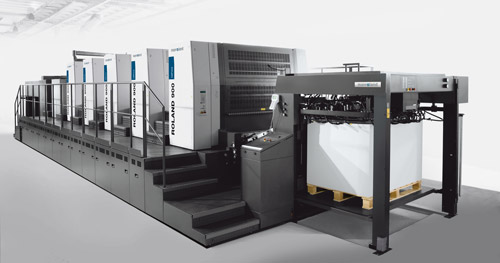As I look around the printing industry landscape, most printers have stabilized their operations at a volume of 10% to 30% less than their 2008 sales numbers. The industry is continuing to consolidate through bankruptcies and mergers. How to grow sales is now one of the major questions on printer’s minds. Differentiation is a good approach, but how and which direction.
It is always good to pick an approach that will support your current business and open opportunities for new business. Also, if you pick an approach that has some high barriers to entry, everyone else isn’t right on your heels. Large format press equipment may be your answer.
How to grow sales is now one of the major questions on printer’s minds.
At first glance this may not be your immediate choice. The offset market isn’t growing, and digital presses and consultative marketing are hot right now. Yet, if this is the future, you also need to address the present, and those offset sales represent a large portion of your current revenue. Offset press technology has not stood still. The capital expenditure paralysis, caused by the Great Recession, has kept a lot of older press equipment out there.

Most printers, if they are considering a new press, will look to replace that 40” press with something similar. They will be content with the fact that they are getting faster makeready and faster speeds. The operative words here are most printers. If the printer down the street does the same thing then there is no differentiation.
Large format presses, 56” and up, represent only 5% to 6% of the world’s press population. Why is this so? For many years large presses ruled in the printing of books, magazines, posters, packaging, etc. As the search for faster speeds, shorter makereadies and higher quality took over, and so did the 40” sheetfed presses. In fact, most of the sheetfed manufacturers halted production of large format presses. Everyone wanted that 5 or 6 color 40” press and that’s what they got. It made sense at the time.
Most printers, if they are considering a new press, will look to replace that 40” press with something similar.
Now technology has evolved. Prepress is completely digital – no more stripping huge flats. Plates are imaged digitally, and large format presses are fast, have quick makereadies and produce high quality. Large format presses can run virtually any substrate from light weight papers to heavy corrugated materials. From a productivity standpoint, they can turn out nearly twice as much production as midsized presses. By moving to large format you can change the rules of the game and establish a difference that will not be easily duplicated.
The large format size can open new markets, often with your current customers. Publications, book production, POP displays, posters, signage, etc. all fall within these machines’ capabilities. Slitters can be added for in-line finishing and creating smaller sheet sizes, making them easier to handle in the bindery. Compared to a 40” press you get additional output with the same input. Makeready times and manning can be the same while throughput can be twice as much.
How big should you go? This will require some thought. What products and markets are you going after? As you go larger you may also want to consider a 56" machine combined with an 80” to 90” digital inkjet printer, which will lessen your investment without lessening your capabilities.
The large format size can open new markets, often with your current customers. Publications, book production, POP displays, posters, signage, etc. all fall within these machines’ capabilities.
All this increased productivity and added capability comes at a cost – hence the barrier to entry not everyone can match. In addition to the larger press you need to upgrade your CTP equipment to handle the larger plate size. In the bindery you will most likely need to get larger cutting and folding equipment, unless you slit everything to a smaller size. There are additional space requirements for the press and larger prepress and bindery equipment, which you need to take into account. The press will also be a larger capital investment.
These barriers to entry will keep most printers from considering this move. If you can do it, this may be the thing you need to differentiate yourself and break ahead of the competition. So as you look around for options and directions to take your business put this one on the table and see how it fits in your business strategy.















Discussion
Only verified members can comment.